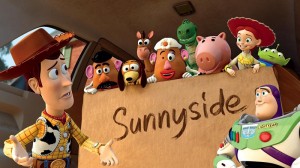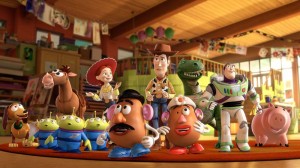[Note: This is Part 2 of my Toy Story 3 Review. Part 1 is yesterday’s blog.]
Before espousing what I think are the themes of Toy Story 3, first a little plot summary.
Toy Story 3 is told from the point of view of Woody (For anyone not familiar with these amazing animated movies, Woody is the Sheriff doll, voiced by Tom Hanks, who gives Woody an Everyman/ Jimmy Stewart “Aw Shucks” vibe).
The main premise: What is going to happen to Woody and the other Toys who are owned by Andy, now that he is college-bound? His mother gives him three options: thrown them out, store them in the attic, or take them with him to college. Andy decides to take Woody and put the rest in the attic.
Unfortunately there is a mix-up and the bag of Toys that Andy wants to be put in the attic is mistaken for trash. His mother puts the bag on the curb for the trash man to pick up.

The story continues with the Toys escaping from the trash bag, jumping in the mom’s car, and ending up at Sunnyside Day Care Center where they think they are in for a good time with lots of kids to play with them.
Woody goes to the school to try to get them to come back to Andy’s house and live in the attic. Woody insists that the Toys’ role is “to be there for Andy.” The Toys are miffed when Woody suggests that, because after all, he was not considered “trash.” Woody explains that Andy meant for them to go to the attic. But the Toys aren’t buying it. Cowgirl Jessie is especially harsh when she tells Woody that she and the other Toys deserve their new life at Sunnyside and want to be played with. She basically tells Woody to beat it.
The Toys soon realize that they are NOT in a Kiddie Heaven. But it is too late. They cannot escape this time. When Woody finds out, he rushes to help his friends bust out of Sunnyside Day Care Prison.
In reading other reviews of Toy Story 3, some themes were mentioned. A reviewer from the Baltimore Sun said TS3 is a “coming of age” movie. I don’t see that. Even though Andy has grown to young adulthood and is giving up childish ways, the story is not about him. Giving up the toys is a device to fuel the plot line. The Toys are not “coming of age” because TOYS DON’T AGE.
A reviewer from NPR said the themes were aging & impermanence, loss & death. Those relate more to Pixar’s Up than TS3.
A reviewer from the San Francisco Chronicle (who I have a bone to pick with over his scathing “grotesque” comments about Sex & the City 2) said the theme of TS3 is a reflection of our economic woes in America. He likens the “being put in the attic…the equivalent of retirement” and “relocating [Woody going off to college with Andy]…the equivalent of changing jobs.”
I see TS3 more in terms of the human aspect of our society than the economic one. I think Americans today are starved for connectedness and a sense of belonging—as evidenced by the popularity of social media. I think people fear loneliness more than they fear poverty. I think people would rather have more friends (good relationships) than more money.
Woody at first is all about preserving what’s best for Andy. After all, Andy is “the boss” and it’s Woody’s “job” to do what Andy wants.
But later he realizes that the welfare of his friends takes precedence over Andy. Andy no longer needs the Toys. But Woody knows the Toys need each other. And they especially need Woody’s leadership to survive.
When Woody arranges for the Toys to live happily ever after at Bonnie’s house—having a new owner and playing with her—he presents the theme of Toy Story 3: Watching out for your friends is more important than what their “job” is supposed to be. Woody knows they BELONG TOGETHER.
And that is exactly what Randy Newman sings about—in his song “We Belong Together”—at the end of the movie.
I think the more “mature audience” appreciates the tight bond that Woody and his pals share. EVERYBODY wants that.

